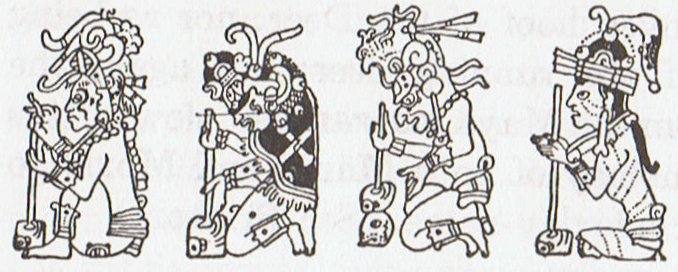4. In the beginning the Loon was calling because the gods were homeless and there was no fire: ... In the morning of the world, there was nothing but water. The Loon was calling, and the old man who at that time bore the Raven's name, Nangkilstlas, asked her why. 'The gods are homeless', the Loon replied. 'I'll see to it', said the old man, without moving from the fire in his house on the floor of the sea. Then as the old man continued to lie by his fire, the Raven flew over the sea. The clouds broke. He flew upward, drove his beak into the sky and scrambled over the rim to the upper world. There he discovered a town, and in one of the houses a woman had just given birth ... The Raven myth does not answer how fire was created, but the Stag myth is beginning with this event: ... A man had a daughter who possessed a wonderful bow and arrow, with which she was able to bring down everything she wanted. But she was lazy and was constantly sleeping. At this her father was angry and said: 'Do not be always sleeping, but take thy bow and shoot at the navel of the ocean, so that we may get fire.' The navel of the ocean was a vast whirlpool in which sticks for making fire by friction were drifting about. At that time men were still without fire. Now the maiden seized her bow, shot into the navel of the ocean, and the material for fire-rubbing sprang ashore. Then the old man was glad ... Driftwood was the solution, fire can be created from it by friction. The Raven myth hints at it: ... The old man gave the Raven two small sticks, like gambling sticks, one black, one multicoloured. He gave him instructions to bite them apart in a certain way and told him to spit the pieces at one another on the surface of the sea. The Raven climbed back up the pole, where he promptly did things backwards, just to see if something interesting would occur, and the pieces bounced apart. It may well be some bits were lost. But when he gathered what he could and tried again - and this time followed the instructions he had been given - the pieces stuck and rumpled and grew to become the mainland and Haida Gwaii ... When Raven climbed up from the old man at the bottom of the sea he had changed from going down (by first falling from the star people high up above to the surface of the sea and then from there by climbing down all the way to his grandfather - his older self - at the bottom of the sea. In other words he had moved through the whole front side and arrived to the beginning of the back side. Therefore he went wintershins when he climbed up, he went in the wrong direction compared to the path of Sun, he had turned around to follow the Moon. Therefore he did things backwards. The beginning of the Sun path should be where there is no fire but where there are pieces of 'driftwood' on the surface, such which Raven later received from the old man. The old man's daughter had brought them to him by shooting an arrow at the navel of the sea. There are 6 minutes of right ascension from spring equinox (north of the equator) to Caph and Sirrah and there are 6 minutes from Sham to Reda:
Albiero means a mistake and possibly it refers to the fact that Cygni is a female constellation - thus a withershins sign in the middle of the male signs. ... Albiero, the now universal title, is in no way associated with Arabia, but apparently was first applied to the star from a misunderstanding as to the word ab ireo in the description of the constellation in the 1515 Almagest. Albirco in the Standard Dictionary undoubtedly is from a type error, as also may be Abbireo, Alberio, and Albeiro, which occasionally are used ... Ab ireo maybe means 'from start' or something like that. It could represent the daughter of the old man, the lazy female archer. But it surely is no mistake - in a world without fire there are no male fire-sticks.
|
